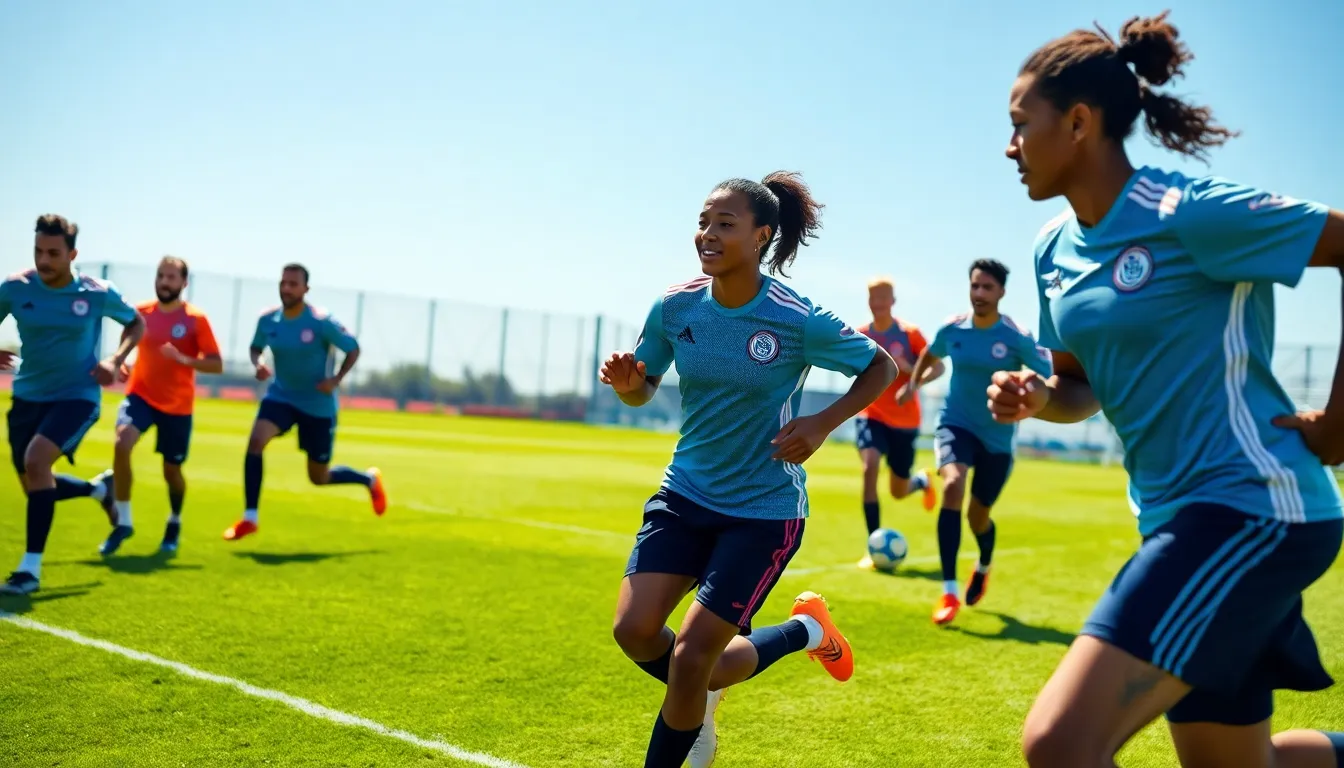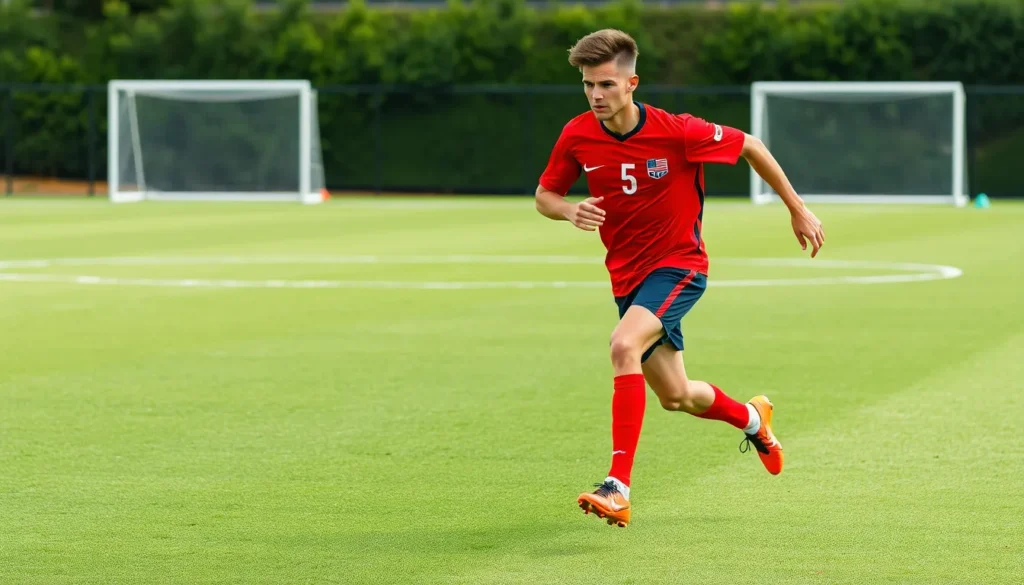Table of Contents
ToggleSoccer isn’t just about fancy footwork and scoring goals; it’s a full-throttle workout that demands peak physical fitness. Picture this: a player sprinting down the field, dodging defenders like they’re in a game of tag. That kind of agility doesn’t come from binge-watching matches on the couch. It comes from dedicated fitness training that turns ordinary athletes into soccer superstars.
What Is Soccer Fitness Training?
Soccer fitness training encompasses specific exercises and conditioning techniques aimed at enhancing players’ performance on the pitch. This training focuses on developing attributes essential for success, such as speed, endurance, strength, and agility. Many players participate in drills that mimic the game’s physical demands, ensuring their bodies adapt to the rigors of soccer.
Cardiovascular endurance plays a significant role in soccer fitness. Players often engage in high-intensity interval training (HIIT) to enhance their stamina, allowing them to maintain peak performance throughout a match. Sprinting drills, for instance, replicate the short bursts of speed required during typical gameplay.
Strength training is equally vital. Incorporating exercises like squats, lunges, and core workouts builds muscle and stability. These exercises contribute to better balance during plays and reduce the risk of injuries. Additionally, increasing overall strength helps players push past opponents effectively.
Agility drills also find a place in soccer fitness training. Ladder drills, cone drills, and shuttle runs improve footwork and quickness. Incorporating these drills enables players to change direction swiftly, a critical skill in evading defenders.
Flexibility is essential too. Stretching routines enhance range of motion, aiding in injury prevention and recovery. Dynamic stretches before training sessions warm muscles, while static stretches afterward promote flexibility.
Combining these elements forms a comprehensive soccer fitness training regimen. This holistic approach not only prepares athletes for the physicality of soccer but also fosters a competitive edge on the field.
Importance of Soccer Fitness Training

Soccer fitness training plays a crucial role in enhancing performance on the field. Players who engage in comprehensive fitness programs often see significant improvements in their game.
Endurance and Stamina
Endurance remains a vital aspect for soccer players. High-intensity interval training (HIIT) builds cardiovascular fitness, enabling athletes to sustain energy throughout matches. Activities like sprints, long runs, and shuttle runs effectively increase stamina for the demands of the game. By integrating aerobic and anaerobic exercises, players develop the ability to recover quickly during short breaks. Consistent training enhances their capacity to maintain speed and agility over extended periods, making it essential for successful gameplay.
Strength and Conditioning
Strength and conditioning form the foundation of a player’s athleticism. Exercises such as squats, lunges, and plyometrics promote muscle development and stability. Functional strength training improves overall body mechanics, allowing players to tackle opponents effectively and maintain balance. Core strength plays a pivotal role, enhancing agility and reducing the risk of injuries. Conditioning drills further refine muscle endurance while preparing athletes to endure the physicality of the sport. Education on proper technique ensures players maximize benefits while supporting injury prevention.
Key Components of Soccer Fitness Training
Soccer fitness training encompasses various components crucial for maximizing player performance on the field. Each element plays a significant role in developing the necessary skills and attributes for success.
Warm-Up and Cool Down
Warm-ups prepare muscles for intense activity, which reduces injury risk. Dynamic stretches, such as leg swings and high knees, increase blood flow and flexibility. Cooling down after training helps in recovery and muscle relaxation. Static stretches, like quadriceps and hamstring stretches, promote flexibility and prevent stiffness.
Agility and Speed Drills
Agility drills enhance quick movements and direction changes vital in soccer. Ladder drills improve foot speed and coordination, while cone drills develop sharp turns. Speed training, through sprints and interval runs, increases overall pace. Short bursts of high-intensity activity simulate game situations, allowing players to adapt during matches.
Strength Training Exercises
Strength training builds muscle and stability essential for soccer players. Exercises like squats and lunges target major muscle groups, enhancing overall power. Core strength, developed through planks and medicine ball exercises, supports balance during play. Resistance training, incorporating weights or bodyweight, fosters resilience against injuries and improves performance on the field.
Designing a Soccer Fitness Training Program
A well-structured soccer fitness training program enhances athletic performance. It involves several key components that optimize a player’s physical capabilities.
Assessing Current Fitness Levels
Evaluating fitness levels helps identify strengths and weaknesses. Players engage in fitness testing that measures endurance, strength, and agility. Common assessments include the beep test for cardiovascular endurance and vertical jumps for leg strength. Results from these tests guide training decisions. Using benchmarks ensures tailored programs that address individual needs. Tracking progress periodically keeps motivation high. Establishing a baseline empowers athletes to understand their starting point and adjust their training accordingly.
Setting Goals and Objectives
Clear goals help athletes maintain focus throughout their training. Players should establish short-term and long-term objectives for progression. Short-term goals could involve improving sprint times over four weeks, while long-term goals may center on enhancing overall endurance for the entire season. SMART criteria can guide the formulation of these objectives: goals need to be Specific, Measurable, Achievable, Relevant, and Time-bound. Setting performance targets encourages accountability and keeps athletes engaged. Goals may involve achieving a specific weightlifting milestone or completing a set number of agility drills weekly for improved speed.
Tips for Effective Soccer Fitness Training
Proper nutrition and hydration play essential roles in enhancing soccer performance. Athletes should consume balanced meals that include carbohydrates, proteins, and healthy fats. Carbohydrates serve as primary energy sources, fueling high-intensity activities. Lean proteins support muscle repair and growth, while fats provide sustained energy. Hydration keeps players performing at peak levels. Drinking water before, during, and after training sessions prevents dehydration and maintains performance. Incorporating electrolyte-rich beverages can further enhance hydration, especially during intense workouts.
Athletes benefit greatly from recovery strategies integrated into their training routines. Recovery allows muscles to heal and rebuild after strenuous activities. Techniques such as foam rolling and massages alleviate muscle tension, enhancing flexibility and reducing fatigue. Scheduling rest days is crucial; they provide time for physical and mental recuperation. Players should also prioritize sleep, aiming for 7-9 hours nightly to support overall recovery. Incorporating active recovery sessions, such as light jogging or swimming, can promote blood circulation and aid in muscle recovery.
Soccer fitness training is essential for any player aiming to excel on the field. By focusing on speed endurance strength and agility athletes can significantly enhance their performance. A well-structured training program not only builds physical capabilities but also fosters mental resilience.
Incorporating HIIT strength training and agility drills ensures players are prepared for the demands of the game. Additionally prioritizing nutrition hydration and recovery strategies supports overall athletic development. With dedication and the right training approach players can transform their skills and gain a competitive edge.




